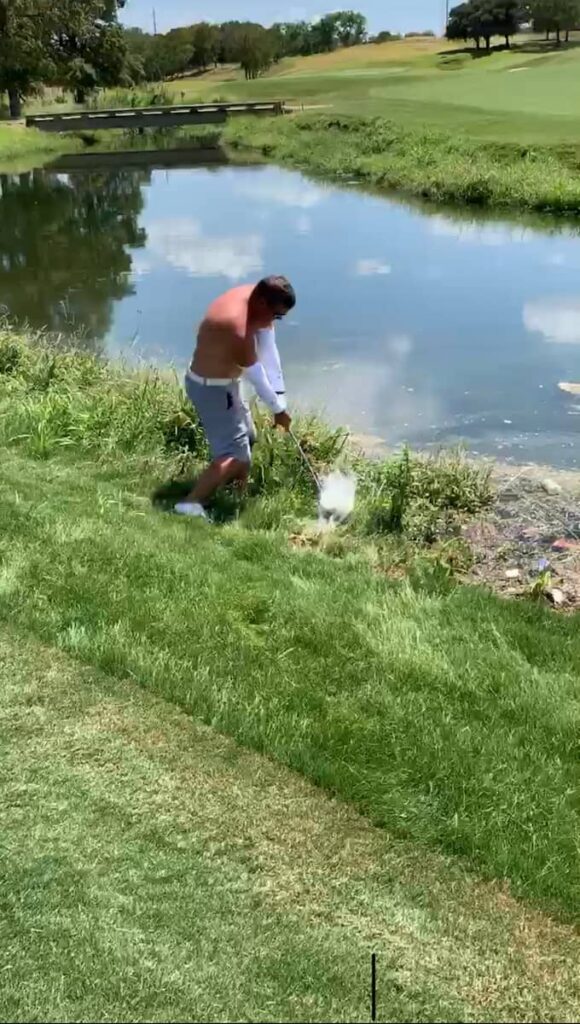Bodies of water are a common feature on golf courses, and they can be a real bummer when you hit your ball into one. But it’s also a common mistake for many golfers, even the pros. This golf rule was changed recently by the PGA Tour, so let’s review the details.
What is a penalty area in golf?
A penalty area in golf is an area of the course that is defined by red or yellow stakes or lines. The terms Water Hazard and Lateral Water Hazard have officially been dropped out of the Rules of Golf.
What is the procedure for hitting a ball in the water and how many strokes do you lose?
In most cases, you will incur a one-stroke penalty for hitting your ball into a Penalty Area if it is unplayable and you need to take a drop. However, if your ball lies inside the Penalty Area, you are allowed to play out of that area without a penalty.
- You are allowed to ground your club
- You are allowed to take practice swings even hitting the ground
- You are allowed to pick up loose impediments
If you do not or can not play it as it lies, you will incur a one-stroke penalty, you will have two options for how to proceed:
1. Stroke and Distance
This means you are to drop a ball by your knees at the original spot played.
2. Drop within a club length
Drop a ball anywhere on an imaginary straight line from the hole and the point where your ball last crossed the penalty area no closer to the hole. Your ball must stay within a club length in any direction after your drop.
3. Lateral Relief
There is a third option to take after you take a penalty stroke but the penalty area must be marked with red stakes or lines. This red Penalty area is a lateral relief and you can proceed by:
- Two club lengths (can use longest club in your bag) from where the ball last crossed the red penalty area, no closer to the hole. When you take your drop in this case, the ball must rest out of the penalty area when it comes to rest and not be closer to the hole.
Two instances where you would re-drop or place the ball when taking relief
- If the ball, keeps rolling forward closer to the hole from where it entered the penalty area
- If the ball keeps rolling out of the two club lengths relief
- If the ball goes back in or touches the penalty area
The procedure is to drop the ball from knee height two times maximum. If the ball does not stay after the second drop, you are allowed to pick the ball up and place it exactly where the ball hit the ground during that second drop.
Another option that is usually a local rule or tournament option is to look for a designated Dropping Zone. There usually is a sign and/or a white painted circle somewhere by the penalty area. This could be anywhere so it even could be on the other side of the penalty area.
You can also simply re-hit your tee shot, though it might be more advantageous to hit from a drop area closer to the hole.
Restrictions when your golf ball is in the Penalty Area
- You can not deem your ball unplayable
- You can not take relief from an abnormal course conditions (such as a bridge or sprinkler irrigation box)
Loose impediments and movable obstructions can be moved even in bunkers. If you move something and your ball accidentally moves, there is no penalty but you must replace the ball to the original location. Loose impediments are unattached natural objects such as sticks, leaves, divot, or anything that is not fixed or growing in the ground.
Tips when our ball is heading towards a Penalty Area
- Try and locate red or yellow stakes to make sure it is a penalty area
- Use a stake or a mark (tree, bush, etc) to mark where your ball crossed the penalty area. Agree with your competitors where the ball last crossed.
- You are allowed to search for a ball for 3 minutes maximum but if you think it went in or saw a splash, please proceed with relief right away.
By knowing these basic rules and options when hitting a ball into a Penalty Area, you can proceed properly in scoring correctly and hold yourself to the integrity of the game.
How to avoid hitting your ball into water
Avoiding hitting your ball into water hazards in golf requires a combination of careful course strategy, precise shot execution, and mental composure. Before each shot, assess the layout of the hole, considering the location of water hazards and their potential impact on your play. Choose clubs and shot trajectories that minimize the risk of landing in water, which mostly depend on how aggressive you want to be with your next shot.
For example, if there’s a lake in front of the green 250 yards out and you can hit your 3 wood only 270 yards (with a roll), then your best bet might be to lay up to within 20 yards of the lake and take your chances with a good pitch on your next shot, especially if you’re in a tight match play game.


